The ASUS Maximus VIII Extreme Review: The Other $500 Option
by Ian Cutress on April 7, 2016 9:00 AM EST- Posted in
- Motherboards
- Gaming
- Asus
- ROG
- Skylake
- Z170
- Thunderbolt 3
System Performance
Not all motherboards are created equal. On the face of it, they should all perform the same and differ only in the functionality they provide - however this is not the case. The obvious pointers are power consumption, but also the ability for the manufacturer to optimize USB speed, audio quality (based on audio codec), POST time and latency. This can come down to manufacturing process and prowess, so these are tested.
Power Consumption
Power consumption was tested on the system while in a single MSI GTX 770 Lightning GPU configuration with a wall meter connected to the OCZ 1250W power supply. This power supply is Gold rated, and as I am in the UK on a 230-240 V supply, leads to ~75% efficiency > 50W, and 90%+ efficiency at 250W, suitable for both idle and multi-GPU loading. This method of power reading allows us to compare the power management of the UEFI and the board to supply components with power under load, and includes typical PSU losses due to efficiency. These are the real world values that consumers may expect from a typical system (minus the monitor) using this motherboard.
While this method for power measurement may not be ideal, and you feel these numbers are not representative due to the high wattage power supply being used (we use the same PSU to remain consistent over a series of reviews, and the fact that some boards on our test bed get tested with three or four high powered GPUs), the important point to take away is the relationship between the numbers. These boards are all under the same conditions, and thus the differences between them should be easy to spot.
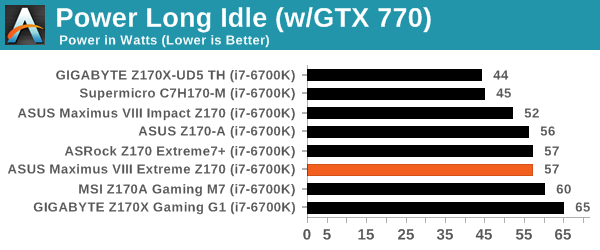
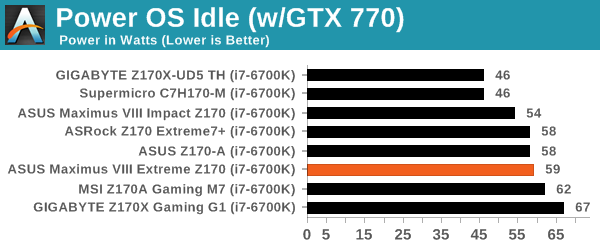
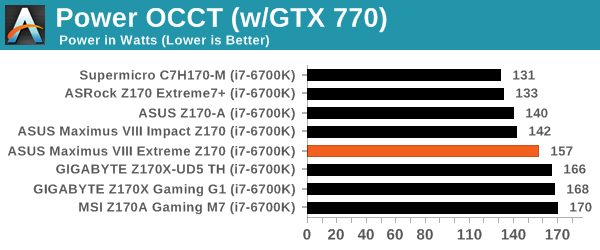
By the nature of being a large E-ATX motherboard with a number of extra controllers, one would expect the M8E to draw a fair bit of power, even under CPU load.
Non UEFI POST Time
Different motherboards have different POST sequences before an operating system is initialized. A lot of this is dependent on the board itself, and POST boot time is determined by the controllers on board (and the sequence of how those extras are organized). As part of our testing, we look at the POST Boot Time using a stopwatch. This is the time from pressing the ON button on the computer to when Windows 7 starts loading. (We discount Windows loading as it is highly variable given Windows specific features.)

Perhaps due to the emergence of Windows 10 and fast boot sequences, fewer motherboard companies are worrying about POST times, although they are now arguably the longest part of a start-up process, especially with the additional DDR4 training needed for validation. The Extreme is reasonably comfortable for its size at 16.50 seconds.
Rightmark Audio Analyzer 6.2.5
Rightmark:AA indicates how well the sound system is built and isolated from electrical interference (either internally or externally). For this test we connect the Line Out to the Line In using a short six inch 3.5mm to 3.5mm high-quality jack, turn the OS speaker volume to 100%, and run the Rightmark default test suite at 192 kHz, 24-bit. The OS is tuned to 192 kHz/24-bit input and output, and the Line-In volume is adjusted until we have the best RMAA value in the mini-pretest. We look specifically at the Dynamic Range of the audio codec used on board, as well as the Total Harmonic Distortion + Noise.

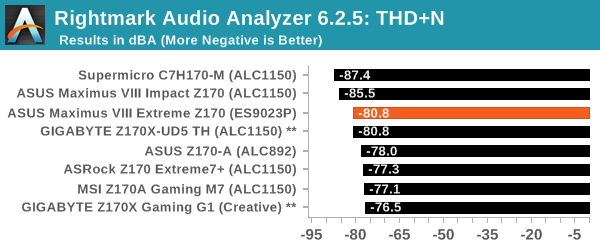
Audio performance from the Extreme gives it the highest SNR of any 100-series motherboard we’ve tested before.
USB Backup
For this benchmark, we transfer a set size of files from the SSD to the USB drive using DiskBench, which monitors the time taken to transfer. The files transferred are a 1.52 GB set of 2867 files across 320 folders – 95% of these files are small typical website files, and the rest (90% of the size) are small 30 second HD videos. In an update to pre-Z87 testing, we also run MaxCPU to load up one of the threads during the test which improves general performance up to 15% by causing all the internal pathways to run at full speed.
Due to the introduction of USB 3.1, as of June 2015 we are adjusting our test to use a dual mSATA USB 3.1 Type-C device which should be capable of saturating both USB 3.0 and USB 3.1 connections. We still use the same data set as before, but now use the new device. Results are shown as seconds taken to complete the data transfer.
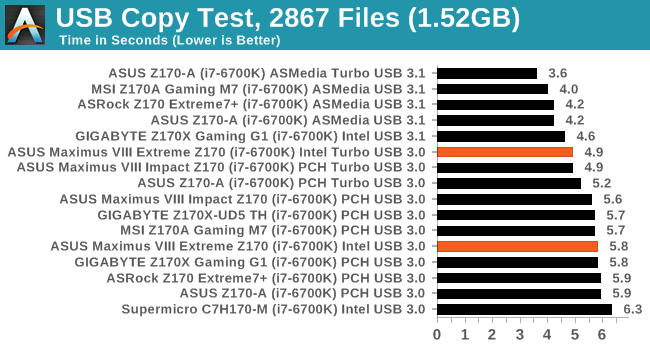
With ASUS’ USB Turbo, we get great performance in our USB 3.0 test. Unfortunately due to the nature of the Intel USB 3.1 controller, our testing software reports erroneous results stating that a transfer is complete faster than could be possible (and it’s a highly variable result). Interestingly we also had problems with the ASMedia controller, which behaved similarly.
DPC Latency
Deferred Procedure Call latency is a way in which Windows handles interrupt servicing. In order to wait for a processor to acknowledge the request, the system will queue all interrupt requests by priority. Critical interrupts will be handled as soon as possible, whereas lesser priority requests such as audio will be further down the line. If the audio device requires data, it will have to wait until the request is processed before the buffer is filled.
If the device drivers of higher priority components in a system are poorly implemented, this can cause delays in request scheduling and process time. This can lead to an empty audio buffer and characteristic audible pauses, pops and clicks. The DPC latency checker measures how much time is taken processing DPCs from driver invocation. The lower the value will result in better audio transfer at smaller buffer sizes. Results are measured in microseconds.

For better or worse, DPC Latency has been a wild ride on Z170. Some companies care deeply, others are not too fussed. Despite this, ASUS seems to have nailed down the formula for a great DPC Latency, and the Maximus VIII Extreme takes the crown from its smaller sibling in style.










70 Comments
View All Comments
BrokenCrayons - Thursday, April 7, 2016 - link
"Yes, blowing that much money on frivolous casual dining, outings and shopping is obviously a demonstration of financial brilliance!"It most certainly isn't wasted money and is part of my "fun cash" allotment to myself after bills are paid and my savings and retirement funds are given their budgeted amounts. So what you're effectively seeing is the result of financial planning and numerous years strictly sticking to a budget. It's not brilliance, but it is a very regimented commitment to a monetary standard.
sweenish - Thursday, April 7, 2016 - link
What you're failing to understand is that "wasted" money to you is not necessarily wasted money to someone else.You're way of doing things is not universal, and neither is how you decide to spend your money for fun. Get over yourself.
BrokenCrayons - Friday, April 8, 2016 - link
I don't think you actually read the chain of posts above yours fully before replying. It doesn't seem like you've comprehended the nuances of the discussion prior to developing feelings about it.A5 - Thursday, April 7, 2016 - link
I don't think anyone buying a $500 motherboard runs in social circles that have the same priorities as you do.It's obviously an insane product, but I assume it brings in a decent profit at low volumes.
ASEdouardD - Thursday, April 7, 2016 - link
As with most things, the rationality of spending that much on a motherboard really depends on how much money you have to spend. If you make 500k a year and like this stuff, why the hell not.Murloc - Thursday, April 7, 2016 - link
yeah people who buy this stuff, besides a few extreme overclockers, are usually rich kids who get into this stuff and just buy the best.They're paying a premium but that premium isn't too much for them so that's good for asus and everybody else.
haukionkannel - Friday, April 8, 2016 - link
Well, I have old Extreme board and the best part is that it has been a trouble free instrument in my setting. The Mother board is now 8-9 years old and still working perfectly!You pay for quality components. I have done only very minor overclocking and preferred stability and durability over maximum performance.
Azethoth - Saturday, April 9, 2016 - link
I just built my Mom a new computer. The last one lasted 7 years. The new one has a Maximus VIII Hero from Fry's. If Fry's stocked the extreme I would have bought that, but limited time meant not waiting for an Amazon delivery. Assuming the same 7 year life span (old comp still worked, just not compatible with 8TB drives), it is less than $100 a year for the MB. Like the old one it is not overclocked and the extra lifespan from better components means I do not have to worry about it like I used to when she got Dells. Does she need 64GB of memory, nope. 2TB Samsung Pro? Nope. 2 8TB HGST He8 drives for the raid, nope. Netgear M4100-D12G switch with all shielded CAT7 cabling? Nope. Thermaltake Core 71 case? Nope, but she wanted a taller case so it is easier to put stuff on top of it and 71 sounds like better quality than 51.Is it worth maxing as much as possible? Yep. I anticipate that this machine will last 10 years and never break, unless 4k VR home movies suddenly becomes a thing and she gets into it and I have to fill up a few more drive bays or get a stupid expensive NAS. Oh yeah and Ashes of the Singularity is gonna scream.
Gastec - Thursday, September 22, 2016 - link
Get outta here! 500 bucks is pocket change, I pay more to fill up my Reventón every week :)arayoflight - Thursday, April 7, 2016 - link
Is there anything meaningful that it offers over Z170 deluxe, which is I guess the only option of you want fast onboard WiFi.